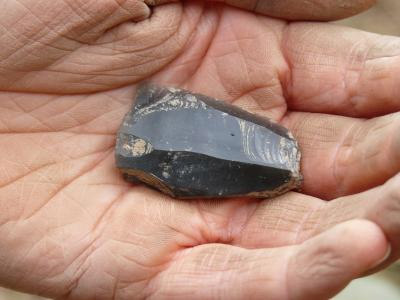Neanderthals Were High-Tech For Their Era

Neanderthal tools found in England suggest our early human relatives hunted with blades and spear tips that were pretty sophisticated, rivaling those made by modern humans, a new analysis suggests.
The research, however, has not been published in a peer-reviewed journal.
Neanderthals inhabited the plains of Europe and parts of Asia as far back as 230,000 years ago. They disappeared from the fossil record more than 20,000 years ago, a few thousand years after modern humans appeared on the scene.
Researcher Matthew Pope, an archaeologist at the University College London, and his colleagues examined stone tools from a site first discovered in 1900 during the construction of a monumental house known as Beedings in West Sussex, England.
"The tools we've found at the site are technologically advanced and potentially older than tools in Britain belonging to our own species, Homo sapiens," Pope said. "It's exciting to think that there's a real possibility these were left by some of the last Neanderthal hunting groups to occupy northern Europe."
He added: "The impression they give is of a population in complete command of both landscape and natural raw materials with a flourishing technology — not a people on the edge of extinction."
It wasn't until the 1980s that the importance of the 2,300 or so tools that were discovered at Beedings came to light. That's when Roger Jacobi of the British Museum revealed the flint tools were technologically advanced and had features similar to other tools from northern Europe dating back to between 35,000 and 42,000 years ago.
Get the world’s most fascinating discoveries delivered straight to your inbox.
Many of the tools had long, straight-sided blades thinned at each end and showed telltale signs of high-velocity impact, suggesting they were used as spear tips. Jacobi reported the area probably served as a lookout from which Neanderthals hunted game herds below and used their tool kits to repair spears for the next kill.
There were some questions about the validity of the past tool excavations at Beedings, Pope added. "Our excavations have proved beyond doubt that the material discovered here was genuine and originated from fissures within the local sandstone," he said.
Pope's team also discovered older, more typical Neanderthal tools, deeper in the cracks.
The team, whose work was funded by English Heritage, hopes to look across the region for similar sites.
- Top 10 Missing Links
- Humans and Neanderthals Might Have Interbred
- Video: Similarities Between Humans and Other Primates
Jeanna Bryner is managing editor of Scientific American. Previously she was editor in chief of Live Science and, prior to that, an editor at Scholastic's Science World magazine. Bryner has an English degree from Salisbury University, a master's degree in biogeochemistry and environmental sciences from the University of Maryland and a graduate science journalism degree from New York University. She has worked as a biologist in Florida, where she monitored wetlands and did field surveys for endangered species, including the gorgeous Florida Scrub Jay. She also received an ocean sciences journalism fellowship from the Woods Hole Oceanographic Institution. She is a firm believer that science is for everyone and that just about everything can be viewed through the lens of science.
